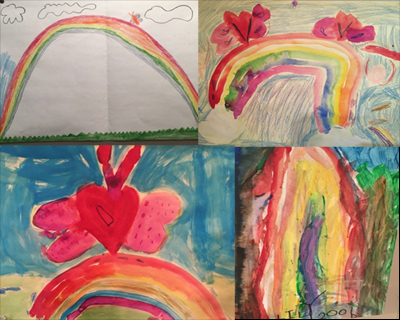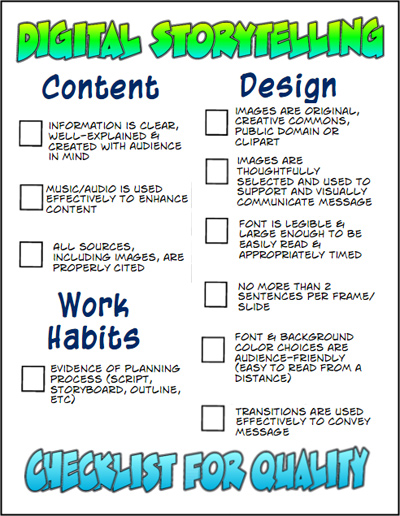
Using freedom within form to support creativity

When my daughter was younger, her school’s art teacher supplied crayons, paint and paper each week and let the students explore by creating whatever they wished. My daughter responded to this assignment by drawing or painting a rainbow every week.
I believe she found this assignment too open-ended, so she made it more manageable by limiting the subject to something she knew. She created, in essence, her own structured assignment.

I have noticed a similar process with some of the teachers in my workshops. Previously, I would demonstrate the broad functionality of a digital tool and instruct attendees to “explore.” While a few teachers would immediately envision a specific use for the tool and would immediately start working toward their goal, many were not engaged…they just scribbled and splotched things here and there on the page. This observation made me realize that providing choice is important, but including some basic guidelines helps ensure that participants will be engaged.
For many people, a completely blank page can be intimidating. Rather than being inspired by potential and possibilities, they feel overwhelmed. A few people will always find complete open-endedness to be exhilarating, but many others are paralyzed and do not know where to start.
Much has been written about the importance of freedom within form. It may seem counterintuitive, but skillfully applied constraints and structure can be helpful, not harmful, when it comes to encouraging creative expression. A Forbes article, How Constraints Drive Genius shares, “Constraints give us a starting point and some building blocks to work with—a problem to solve, an innovative twist to be revealed, or a person to please.”
Structures are the foundation of good learning environments. However, structures that are too closed can stifle curiosity and interfere with the deeper understanding we want our learners to develop. How can educators design structures that support students’ creativity in their use of open-ended tools without imposing arbitrary constraints?
While we don’t always know where our creative journeys might lead us, we should begin by defining our goals for student learning. Make learning intentions explicitly visible to students to set a course for meaningful, quality work. Students are still free to take “the road less traveled” or go to off the beaten path, but they will still be aware of the ultimate destination.
I once worked with an artist-turned-teacher whose students consistently produced breathtakingly beautiful creations with the digital tools at their disposal. Her secret to success was to sprinkle a few art tips into her rubrics. For example, she noticed that students put more effort and artistry into creations that included backgrounds, so her rubric included points for eliminating white space and thoughtful texture choices.
My colleage Liat Walker and I created this roadmap to guide students through the creation of animated videos as an assessment of their learning. We thought about the elements of content and design that would lead to quality output. We also wanted to clearly define what was expected as part of the process. We titled this section of the process “work habits” to communicate the importance of preparing before jumping in to create.

When we use rubrics and checklists to define criteria for success, we give students a map they can follow to successful completion of their projects. Like most maps, there isn’t typically a single route; you can take the highway, the winding back roads, or a combination of the two.
I’ve heard from many teachers that they are reluctant to show examples because students may just recreate the sample instead of creating something unique. Models are powerful teaching tools; students who stick close to the template usually do so because they need (or think they need) more support before trusting themselves to take creative risks.
Sharing high-quality examples is one of the most effective ways to inspire students to create their own high-quality work. Collecting and creating these samples is planning time well-spent. Using work from previous students to demonstrate excellence is a powerful motivator. Your current students will want to create the quality products you will use to motivate next year’s class.
If you are concerned about students reproducing the examples, work to create or find a sample that shows a similar process for different content. Some students will need this scaffolding; you can instruct them to add or change features to make it their own. Students who need less scaffolding can be instructed to create a final product that is stylistically or factually different than the samples.
Many educators who value creativity have decried the traditional focus on the end product. It is true that much of the important learning takes place during the process of creation, but students also benefit from creating a high-quality, meaningful deliverable.
One of the tenets of project-based learning is the need to share something with a larger audience, such as the whole class, the whole school, or the entire world. If we place all of the importance on process, without goals or deadlines, we fail to develop a vital understanding of what it means to create. Processes leading to an end-point that will be presented, published or otherwise shared with an audience help keep students focused and on-track.
Art teacher Shana Gutterman describes her desire for students to leave her class with a quality art product while still wanting to give them choice; she ultimately concludes that there is space for both. “After a lot of thought, I have decided that I do not need to be a product-only teacher or a process-only teacher. I can combine the ideas.”
Giving students choice is an essential element of quality teaching, but unlimited choice can be counterproductive. Giving careful consideration to basic structures can channel student creativity and positively impact productivity.

Wixie
Share your ideas, imagination, and understanding through writing, art, voice, and video.

Rubric Maker
Create custom rubrics for your classroom.

Pics4Learning
A curated, copyright-friendly image library that is safe and free for education.

Wriddle
Write, record, and illustrate a sentence.

Get creative classroom ideas delivered straight to your inbox once a month.
Topics